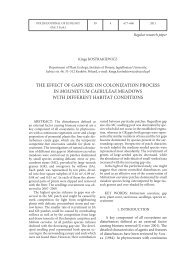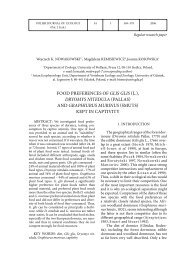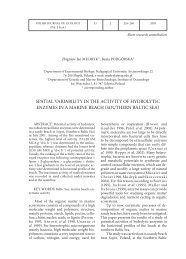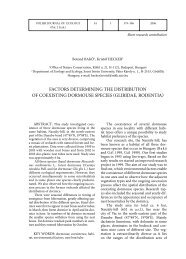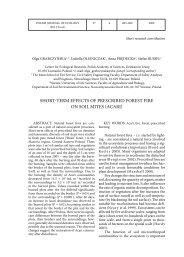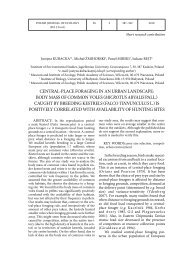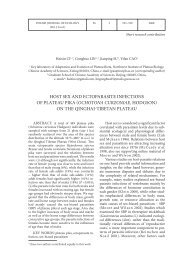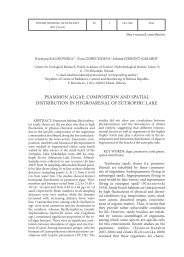NATURAL FORESTS OF QUERCUS ROBUR L. IN NORTHWEST ...
NATURAL FORESTS OF QUERCUS ROBUR L. IN NORTHWEST ...
NATURAL FORESTS OF QUERCUS ROBUR L. IN NORTHWEST ...
You also want an ePaper? Increase the reach of your titles
YUMPU automatically turns print PDFs into web optimized ePapers that Google loves.
POLISH JOURNAL <strong>OF</strong> ECOLOGY<br />
(Pol. J. Ecol.)<br />
55 2 401–404 2007<br />
Research note<br />
Ignacio JAVIER DÍAZ-MAROTO, Pablo VILA-LAMEIRO<br />
Department of Agroforestry Engineering, University of Santiago de Compostela, Campus Universitario<br />
s/n, E-27002 Lugo, Spain. diazmaro@lugo.usc.es<br />
<strong>NATURAL</strong> <strong>FORESTS</strong> <strong>OF</strong> <strong>QUERCUS</strong> <strong>ROBUR</strong> L. <strong>IN</strong> <strong>NORTHWEST</strong><br />
SPA<strong>IN</strong> – MA<strong>IN</strong> PROPERTIES <strong>OF</strong> SOILS<br />
ABSTRACT: The main properties of the<br />
soils under oak (Quercus robur L.) forests in<br />
Galicia (NW Spain) were characterized. Eleven<br />
edaphic parameters (pH, OM, N, C/N ratio, P,<br />
K, Ca, Mg, sand, silt and clay) were estimated in<br />
39 soil samples. Siliceous substrates were present<br />
in all stands and the soils were found to be the<br />
cambisols. The values of chemical parameters are<br />
similar to those considered as the optimal ones by<br />
other authors (i.e., average pH close to 5, average<br />
C/N ratio close to 15) with the exception of the<br />
organic matter which is slightly higher; the average<br />
value is equal to 8.64 ± 5.19. The content of<br />
nutrients can be considered as the low or medium<br />
(for instance, the potassium is only 73 ppm) as<br />
compared with other forests in the study area, except<br />
the content of phosphorus, which is considerably<br />
higher (21.8 ppm versus 1–6 ppm).<br />
KEY WORDS: oak forests, soil properties,<br />
Galicia, Spain<br />
Soils in Galicia (NW Spain) are acidic.<br />
The high precipitation, particularly the intensity<br />
of rainfall during the rainy seasons<br />
(autumn and spring) is decisive in this region<br />
(Carballeira et al. 1983). The drainage<br />
conditions favour water infiltration into soil<br />
and increase the run-off and temperate thermic<br />
regime allow the advance of acidification<br />
(Camps et al. 2004). However, slightly acidic<br />
soils are found to be more favourable than alkaline<br />
ones to support the diverse forest vegetation<br />
(Hardtle et al. 2005). The Galician<br />
soils under oak forests that grow on acidic<br />
substrates are oligotrophic or mesotrophic,<br />
with a high C/N ratio, very low saturation<br />
level and low contents of exchangeable cations;<br />
however, phosphorus content is rather<br />
high (Bara et al. 1985).<br />
The studied stands are located in Galicia,<br />
NW Spain (Fig. 1) at altitude average of 508<br />
m; the slopes are steeper than 20% in half of<br />
the study area. Siliceous substrates were present<br />
in all stands, with dominance of granite<br />
and schist and the soils are of cambisol type<br />
(Díaz-Maroto and Vila-Lameiro 2006).<br />
The climate presents generally an oceanic<br />
pattern, with annual rainfall between 600<br />
and 3000 mm (Carballeira et al. 1983).<br />
According to the National Forest inventory,<br />
stands of native hardwoods, mainly Quercus<br />
spp., cover in Galicia 27% of the total woodland<br />
area, i.e., 375922 ha. In 1986, these forests<br />
covered only 20%. Pure stands of Quercus robur<br />
cover 187789 ha, almost 14% of the woodland<br />
area in the region (DGCONA, 2001).<br />
A total of 39 sampling sites were chosen,<br />
in relation to physiography and general soil<br />
journal 10.indb 401 2007-06-08 11:38:22
402<br />
Ignacio Javier Díaz-Maroto, Pablo Vila-Lameiro<br />
SPA<strong>IN</strong><br />
Fig. 1. Distribution of the studied Quercus robur stands in Galicia (Spain).<br />
characteristics (Fig. 1). To describe the soil<br />
profiles, the pits of 2 m length and 80 cm<br />
width were dug at each site. The horizons<br />
were differentiated according to colour and/<br />
or texture. One sample of each horizon (about<br />
2 kg) was collected and following features<br />
were analyzed (FAO, 1977): Munsell colour,<br />
moisture (by oven drying to constant weight<br />
at 105°C), pH (in H 2<br />
O – 1:2.5 soil solution),<br />
total nitrogen (semi-micro Kjeldahl method),<br />
carbon (Walkley and Black method),<br />
organic matter (% carbon × 1.724), C/N ratio,<br />
exchangeable cations (by extraction with<br />
1N ammonium acetate at pH=7 and quantified<br />
by atomic absorption (Ca and Mg) and<br />
by emission (K), available phosphorus (Bray<br />
and Kurtz method), and physical analysis<br />
(separation of the fine earth, elements < 2<br />
mm of diameter: sand, silt and clay). In total<br />
11 soil parameters were estimated (Table 1).<br />
An univariable analysis was applied to<br />
these parameters (Díaz-Maroto et al.<br />
2006), with a normality test to verify the normal<br />
distribution (Walpole et al. 1999). To<br />
assess the variability of soils the bivariable<br />
correlation and Principal Component Analysis<br />
(PCA) (Sas Institute Inc., 2004) were applied.<br />
The average values of following parameters:<br />
pH, nitrogen and C/N ratio are similar<br />
to these reported as the optimal ones by Bara<br />
et al. (1985) and Rozados et al. (2000). The<br />
values of OM are generally high and slightly<br />
higher than given by above authors. Most of<br />
soils are strongly acid (4.7 ≤ pH
Soil properties of oak forests<br />
403<br />
Table 1. Average, standard deviation (±SD), coefficient of variation (CV), and the range of values<br />
(max-min) of soil parameters (n=39).<br />
Parameter Average ± SD CV % max-min<br />
pH 4.85 ± 0.46 9 6.15–3.92<br />
OM (%) 8.64 ± 5.19 60 23.31–1.04<br />
N (%) 0.307 ± 0.178 58 0.793–0.04<br />
C/N 14.6 ± 4.5 31 29.6–6.9<br />
P (ppm) 21.8 ± 28.9 133 117.2–0.4<br />
K (ppm) 73 ± 40 55 231–9<br />
Ca (ppm) 120 ± 216 180 1297–3<br />
Mg (ppm) 29 ± 21 72 85–0<br />
SAND (%) 66 ± 21 31 89–14<br />
SILT (%) 23 ± 20 92 85–7<br />
CLAY (%) 11 ± 5 45 27–1<br />
Table 2. Importance of each parameter in the soil properties variability as revealed by PCA analysis.<br />
Parameter Vector 1 Vector 2 Vector 3 Vector 4 Vector 5<br />
pH -0.692 0.249 0.500 0.236 -0.177<br />
OM (%) 0.870 0.185 0.339 -0.100 0.043<br />
N (%) 0.848 0.139 0.301 -0.016 0.054<br />
P (ppm) -0.392 0.436 0.185 0.502 0.247<br />
K (ppm) 0.557 0.298 -0.456 0.428 0.222<br />
SAND (%) -0.337 0.761 -0.119 -0.383 0.060<br />
SILT (%) 0.196 -0.802 0.050 0.472 -0.061<br />
CLAY (%) 0.568 0.246 0.276 -0.430 -0.035<br />
the substrates poor in bases. For instance, the<br />
phosphorus content is 21.8 ppm (Table 1);<br />
it is much lower than the values given for a<br />
loamy oak topsoil by Neirynck et al. (2000)<br />
(294–387 ppm).<br />
The contribution of sand, 66 %, is near<br />
the data reported by Bara et al. (1985),<br />
i.e. 72% but the silt fraction is higher, 23%<br />
(Table 1). These values can result from the location<br />
of studied stands on rather steep slope<br />
with advanced soil erosion (Díaz-Maroto<br />
et al. 2005).<br />
Bivariable correlation analysis shows that<br />
pH and OM contribute to the largest number<br />
of significant relationships, including<br />
the relation between these two parameters<br />
(Pearson linear coefficient, r = –0.44), as<br />
well as with other parameters, like OM-C/N<br />
(r = 0.42). Despite the possible relationship<br />
of some chemical parameters with the silt<br />
fraction (Neir ynck et al. 2000), only percentage<br />
of total clay is significantly correlated<br />
with chemical parameters, particularly<br />
with OM (r = 0.69) and N (r = 0.66).<br />
The results were also analyzed with PCA<br />
and five new variables or vectors combination<br />
from 11 initial parameters (Table 2)<br />
were obtained. The first vector is influenced,<br />
above all, by OM and N content. It could be<br />
interpreted as “absence of mineralization”<br />
(Mansson and Falkengren-Grerup<br />
2003; L andgraf et al. 2006). In the second,<br />
the special importance of SAND and SILT<br />
was manifested with opposite sign, positive<br />
journal 10.indb 403 2007-06-08 11:38:22
404<br />
Ignacio Javier Díaz-Maroto, Pablo Vila-Lameiro<br />
for the first one. It could be called “the sandy<br />
level” (Neir ynck et al. 2000). Third vector<br />
represents the importance of pH, and it<br />
could be called as “acidity”. In the fourth and<br />
fifth vectors, P and K are mainly represented,<br />
and they could be denominated as “trophic<br />
properties” (Hagen-Thorn et al. 2006).<br />
The results of study of the oak forest soils<br />
from Galicia indicate that the variability of<br />
the properties of acidic nutrient and poor<br />
soils in this region is mainly explained by the<br />
amount of organic matter and nitrogen as<br />
well as by pH and contribution of sand and<br />
clay.<br />
REFERENCES<br />
Bara S., Rigueiro A., Gil M.C., Mansilla<br />
P., Alonso M. 1985 – Efectos ecológicos del<br />
Eucalyptus globulus en Galicia. Estudio comparativo<br />
con Pinus pinaster y Quercus robur<br />
[Ecological effects of the Eucalyptus globulus<br />
in Galicia. Comparative study with Pinus pinaster<br />
and Quercus robur] – Monografías <strong>IN</strong>IA<br />
50, MAPA (in Spanish).<br />
Camps M., Mourenza C., Alvarez E.,<br />
Macias F. 2004 – Influence of parent material<br />
and soil type on the root chemistry of<br />
forest species grown on acid soils – For. Ecol.<br />
Manage. 193: 307–320.<br />
Carballeira A., Devesa C., Retuerto R.,<br />
Santillan E., Ucieda F. 1983 – Bioclimatología<br />
de Galicia [Bioclimatology of Galicia]<br />
– Xunta de Galicia (in Spanish).<br />
Díaz-Maroto I.J., Vila-Lameiro P., Silva-Pando<br />
F.J. 2005 – Autoecology of oaks<br />
(Quercus robur L.) in Galicia (Spain) – Ann.<br />
For. Sci. 62: 737–749 (in French).<br />
Díaz-Maroto I.J., Vila-Lameiro P. 2006<br />
– Litter production and composition in natural<br />
stands of Quercus robur L., Galicia, Spain<br />
– Pol. J. Ecol. 54: 429–439.<br />
Díaz-Maroto I.J., Fernández-Parajes J.,<br />
Vila-L ameiro P. 2006 – Autecology of rebollo<br />
oak (Quercus pyrenaica Willd.) in Galicia<br />
(Spain) – Ann. For. Sci. 63: 157–167 (in<br />
French).<br />
D GCONA 2001 – III Inventario Forestal Nacional:<br />
Galicia [Third National Forest Inventory]<br />
– Ministerio de Medio Ambiente, Madrid (in<br />
Spanish).<br />
FAO 1977 – Guía para la descripción de perfiles<br />
de suelos [Guide for the description of soil<br />
profiles] – Servicio de Conservación de Suelos<br />
(in Spanish).<br />
Hagen-Thorn A., Callesen I., Armolaitis<br />
K., Nihlgard B. 2004 – The impact of six<br />
European tree species on the chemistry of<br />
mineral topsoil in forest plantations on former<br />
agricultural land – For. Ecol. Manage.<br />
195: 373–384.<br />
Hagen-Thorn A., Varnagiryte I., Nihlgard<br />
B., Armolaitis K. 2006 – Autumn<br />
nutrient resorption and losses in four deciduous<br />
forest tree species – For. Ecol. Manage.<br />
228: 33–39.<br />
Hardtle W., von Oheimb G., Westphal<br />
C. 2005 – Relationships between the vegetation<br />
and soil conditions in beech and beechoak<br />
forests of northern Germany – Plant Ecol.<br />
177: 113–124.<br />
Landgraf D., Leinweber P., Makeschin<br />
F. 2006 – Cold and hot water-extractable organic<br />
matter as indicators of litter decomposition<br />
in forest soils – J. Plant Nutr. Soil Sci. 169:<br />
76–82.<br />
Mansson K.F., Falkengren-Grerup U.<br />
2003 – The effect of nitrogen deposition on<br />
nitrification, carbon and nitrogen mineralization<br />
and litter C:N ratios in oak (Q. robur) forests<br />
– For. Ecol. Manage. 179: 455–467.<br />
Neirynck J., Mirtcheva S., Sioen G.,<br />
Lust N. 2000 – Impact of Tilia platyphyllos<br />
Scop., Fraxinus excelsior L., Acer pseudoplatanus<br />
L., Quercus robur L. and Fagus sylvatica<br />
L. on earthworm biomass and physico-chemical<br />
properties of a loamy topsoil – For. Ecol.<br />
Manage. 133: 275–286.<br />
Rozados M.J., Silva-Pando F.J., Alonso<br />
M., Ignacio M.F. 2000 – Edaphic and foliar<br />
parameters in a stand of Quercus robur L.<br />
in Galicia (Spain) – Inv. Agr. Sist. Rec. For. 9<br />
(1):17–30 (in Spanish).<br />
Sas Institute Inc. 2004 – SAS/STAT® 9.1. User’s<br />
Guide – Cary, NC: SAS Institute Inc.<br />
Walpole R.E., Myers R.H., Myers S.L.<br />
1999 – Probability and statistic for engineers<br />
– Prentice Hall.<br />
(Received after revising January 2007)<br />
journal 10.indb 404 2007-06-08 11:38:22




